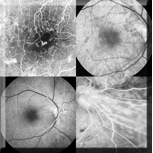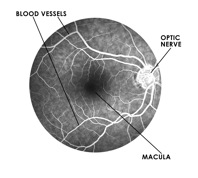 Fluorescein Angiography (FA) is a diagnostic procedure that uses a special camera to record the blood flow in the RETINA – the light sensitive tissue at the back of the eye.
Fluorescein Angiography (FA) is a diagnostic procedure that uses a special camera to record the blood flow in the RETINA – the light sensitive tissue at the back of the eye.
The test does not involve any direct contact with the eyes. Your eyes will be dilated before the procedure.
Fluorescein dye is injected into a vein in the arm/hand. As dye passes through the blood vessels of your eye, photographs are taken to record the blood flow in your retina. The photographs can reveal abnormal blood vessels or damage to the lining underneath the retina.
 The images will be captured in black and white. The dye will fluoresce in the blood vessels and be recorded as light grey or white in the image. Interpretation of the abnormal angiogram relies on the identification of areas that exhibit hypofluorescence (darkness) or hyperfluorescence (brightness).
The images will be captured in black and white. The dye will fluoresce in the blood vessels and be recorded as light grey or white in the image. Interpretation of the abnormal angiogram relies on the identification of areas that exhibit hypofluorescence (darkness) or hyperfluorescence (brightness).
Fluorescein angiograms are often recommended to follow the course of a disease and to monitor treatment results. It is particularly useful in the management of diabetic retinopathy and macular degeneration.

What will you experience?
The actual procedure will take 10-20 minutes. The average length of stay in our department can be 1-2 hours.
Your medical history will be reviewed by a nurse before the test.
Some individuals might experience slight nausea during the procedure. The feeling passes within a few seconds.
If the dye leaks out of a fragile vein during the injection, some localized burning and yellow staining of the skin may occur.
Allergic reactions to the dye are rare. If they occur, they may cause a skin rash and itching. This reaction is treated with antihistamines. Severe allergic reactions are extremely rare.
 Your pupils will be dilated for the FA.
Your pupils will be dilated for the FA.
After the pupils are dilated your vision may become blurred. Driving is not recommended when your pupils are dilated.
Before the procedure
EAT, DRINK & TAKE your medications as you usually do.
DRINK an extra 2-3 cups of water before the procedure.
AVOID coffee, tea, or caffeinated beverages.
BRING an English translator.
BRING your lens case, if you wear contact lenses, as you will need to remove the contacts.